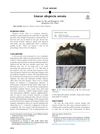Three Types of Alopecia in One Patient: A Case of Central Centrifugal Cicatricial Alopecia, Alopecia Areata, and Telogen Effluvium
July 2025
in “
JAAD Case Reports
”

TLDR A thorough assessment and combined treatment are crucial for managing complex alopecia, especially in patients with skin of color.
This case report discusses a 48-year-old African American woman diagnosed with three types of alopecia: alopecia areata (AA), central centrifugal cicatricial alopecia (CCCA), and telogen effluvium (TE). The patient's history of gastric bypass surgery, significant weight loss, and vitamin deficiencies likely contributed to the TE, while the CCCA was confirmed through biopsy findings of follicular scarring and inflammation. The report emphasizes the importance of thorough clinical assessment and a multimodal treatment approach, including anti-inflammatory and immunosuppressive therapies, to manage complex alopecia cases effectively, particularly in patients with skin of color. The patient was treated with doxycycline, clobetasol, triamcinolone, and tofacitinib, but was lost to follow-up.



